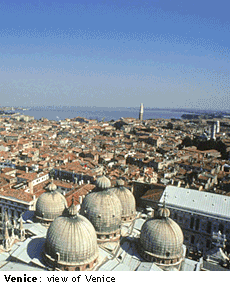History and culture
The first human settlements on the Venice Lagoon islands date back to the 5th and 6th centuries, when the inhabitants from the mainland came to this semi-swamp area to escape the barbaric invasions that followed the fall of the Roman Empire. The populations coming from mainland Venice settled in the lagoon, fighting as hard as they could to survive: little by little this group of pieces of land surrounded by water took on the semblance of a real town, a town that was so unique and special that it would become the only one of its kind in the world. The new inhabitants built several rafts of various sizes, supported by strong wooden poles that were fixed to the underside. The rafts were connected to each other with wooden walkways and houses, buildings and monuments were then built on them.
When Venice had a big enough population to begin to deserve the title of city, it was then annexed to the Byzantine Empire, while maintaining its own independence. In 697, Venice elected its first Doge, giving life to a new government: the Dogado (Maritime Empire). However, the event that finally made Venice’s name in the world took place in 828, when two enterprising Venetian merchants stole the Apostle Mark’s body from Alessandria in Egypt, and secretly transported it to Venice. A huge church, consecrated in 1094, was built to house the remains of the Saint, who then became the patron saint of the city: the Basilica of San Marco.
Since the very beginning, Venice showed strong inclinations towards trade. This increased to the point that at the end of the 11th century, the city set up close trading connections with Byzantium. This was the start of the Republic of Venice, which was finally consecrated in 1202 through the 4th crusade that saw the conquering of Byzantium and then the islands in the Aegean and Ionian Seas. The eastern city was sacked and the booty was taken to Venice, where it was used to decorate churches and palaces. The four bronze horses that still adorn the main facade of the Basilica of San Marco were also part of that booty.
After the 4th crusade, Venice gained a strong political role due to the fact that it now controlled a large part of the Mediterranean and it also increased its military power and its trading.
The city’s historical rivalry with Genoa exploded under the form of four wars that were fought one after the other until a truce was finally agreed at the end of 1381, when Venice beat Genoa in the famous Battle of Chioggia (1380). Venice then realized that it was necessary for the city to have bases on the mainland too and began to expand towards Padua, Vicenza, Verona, Brescia and Bergamo. Venice’s prestige grew at the same rate as the increase in the land it controlled and was thus given the name of Serenissima. However, danger was round the corner: the Serenissima was so busy expanding on the mainland that it did not realize that the Turks’ power was expanding rapidly, to the point where they took over Constantinople (Byzantium) and some cities on the Greek and Albanian coastlines.
The League of Cambrai was founded in 1508: this was a sort of coalition against Venice which most of the European powers joined. Venice managed to maintain some of its land after seven years of war, but it lost its control over the Mediterranean.
In the 17th century, the Serenissima had to give up Crete, one of its historical lands and the whole of the Peloponnesus area to the Turkish Empire. In the period that followed, Venice’s political power was seriously damaged but there was a considerable increase of the arts and literature in the city, which gave rise to the creation of works of art by Tiepolo, Pietro Longhi and Canova and to theatre plays by Carlo Goldoni.
In 1797, Napoleone Bonaparte conquered Venice, and sacked the whole area, just as he did in the rest of the country. A short while later the Emperor handed over the city to Austria, a ruler that was never accepted by the Venetians: in 1848, the Austrians were run out of the city by a group led by Daniele Manin, and the second Republic of Venice was proclaimed. This new republic did not last for long, however, as Venice was annexed to the new Kingdom of Italy in 1866.
Go to directories of Web Sites
|
|
|


